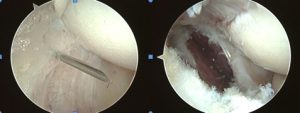Tennis Elbow
Lateral epicondylitis (tennis elbow), is a very familiar term used to describe pain on the outside (lateral aspect) of the elbow. It usually affects middle aged patients with peak incidence is reported to be in early 50s.
Why Does It Occur ?
The exact cause remains unclear although it is associated with repetitive overuse. Tennis elbow is the term used to describe inflammation of the origin of extensor carpi radialis brevis (ECRB) tendon, which is located on the outer aspect of elbow joint. In later stage it can also involve other tendons.
Symptoms
- Pain during activities that require repetitive rotation of the forearm with the elbow in near full extension. Classically these movements are replicated when serving in Tennis, hence the name.
- Pain typically gets worse when gripping small objects or when twisting the forearm like turning handle of a door.
- The pain may sometimes radiate into forearm or wrist.
Investigations
- MRI: Shows tendon thickening at the Below epicondyle.

- Plain X-ray: usually normal, but helps to exclude other conditions like calcific tendinitis or osteoarthritis of lateral compartment.
- Ultrasound scan: confirms inflammation or tears.
Treatment
- Around 95% of patients will get better with rest, ice, bracing and physical therapy to include stretching and strengthening exercises.
- Injections: Second line treatment. Local injections of a long acting steroid preparation like Triamcinolone or depomedrone may help. The effect is usually transient. PRP injection has also been shown to be beneficial in certain patients.
- Operation: Reserved for failed conservative treatment, and success rates vary from 70% – 90%. The operation can be done arthroscopically or open.
Elbow Arthroscopy: I prefer arthroscopic release as first line surgery – it offers a quicker rehabilitation and avoids disrupting the other tendons of extensor origin. Additionally, it enables treatment of other relevant pathology like radial plica resection or removal of loose body at the same time.

Patients usually go home the same day and can start moving the elbow as pain allows. Most patients report good pain relief within 6-12 weeks.
Open release: Usually more painful postoperatively and take longer for rehabilitation till the common extensor origin is healed.

